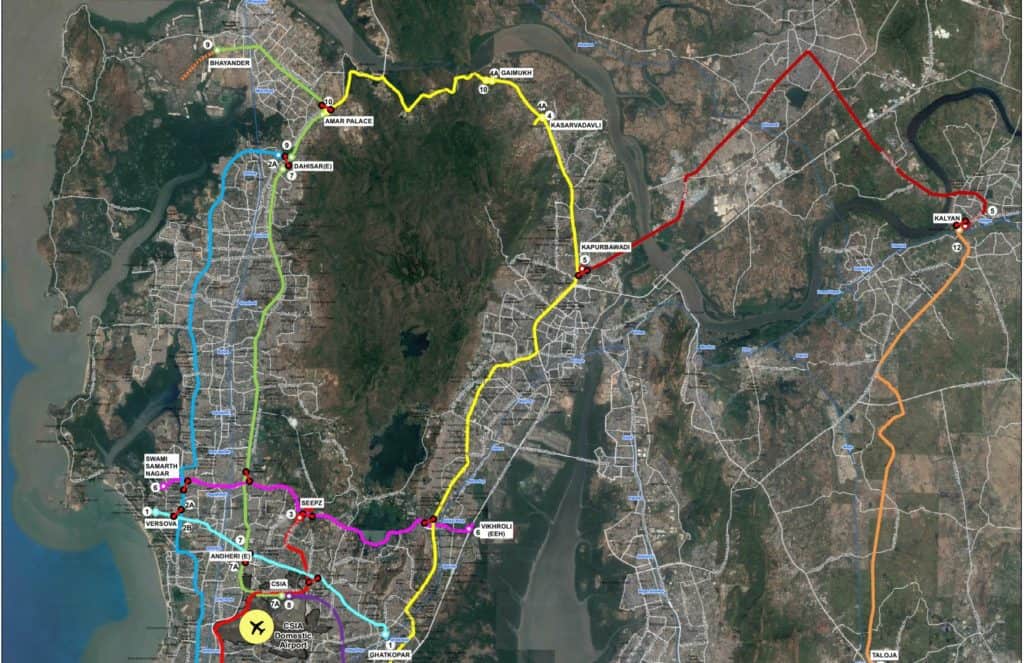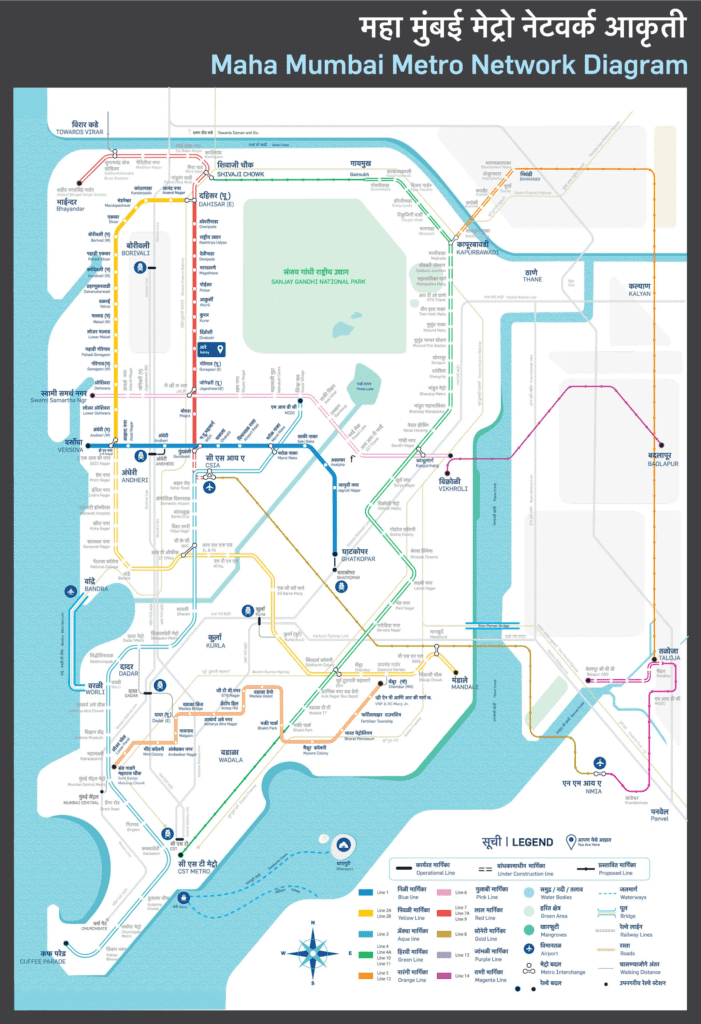On the occasion of Gudi Padwa on April 2nd, two new Mumbai metro lines – Line 2A and 7 – made their debut. They interconnect at Dahisar and parallelly extend into the suburbs: to DN Nagar in Andheri West and Andheri East respectively.
The two yellow and red lines were first proposed and approved in 2015. Construction started in 2016 with a deadline of 2019, and yet, only Phase 1 of the lines is operational today, cutting the journey short to Dahanukarwadi, Kandivali on Line 2A and Aarey, Goregaon on Line 7. The remainder will launch as Phase 2 in five-six months. August 15th is a tentative date.
In their full length, they will intersect with DN Nagar and Andheri East station on the first Mumbai Metro Line 1 that has been operational since 2014 between Versova and Ghatkopar. The improved integration and frequency will encourage a shift from the congested Western Express Highway (WEH) and aims to ferry over a million commuters daily by 2031. Additionally introduced is quick electronic ticketing through WhatsApp.
What’s next
The three metro lines are only early stages of Mumbai’s ambitious metro project. The network has been bumped from 11 km to almost 50 km after 8 years, and the wait for the next new line will not be nearly as long. The Mumbai Metropolitan Region Development Authority (MMRDA) has started construction on nine metro lines. Three more are in the tendering stage, and another three have been planned.
“In 3-4 years, Mumbai will be well connected by the metro in all directions across north-south, east-west,” said SVR Srinivas, metropolitan commissioner of the MMRDA. By 2030, the network plans to cover 337 km and have over 200 stations, extending well into the satellite cities of Thane and Navi Mumbai.
Here are the latest updates on the lines and when you can expect to be able to board them:
| Metro Line | Line Colour | Corridor | Length (Km) | Number of Stations | Status | Launch Date |
|---|---|---|---|---|---|---|
| Line-1 | Blue ___ | Verova – Andheri – Ghatkopar | 11.4 | 12 | Operational | 2014 |
| Line-2A | Yellow ___ | Dahisar – DN Nagar | 18.6 | 17 | Partially Operational | 2022 |
| Line-2B | Yellow ___ | DN Nagar – Mandale | 23.6 | 20 | Under Construction | 2023 |
| Line-3 | Aqua ___ | Colaba – Bandra – Seepz | 33.5 | 27 | Under Construction | 2024 |
| Line-4 | Green ___ | Wadala – Kasarawadavali | 32.3 | 30 | Under Construction | 2025 |
| Line-4A | Green ___ | Kasarawadavali – Gaimukh | 2.9 | 2 | Under Construction | 2025 |
| Line-5 | Orange ___ | Thane – Bhiwandi – Kalyan | 23.5 | 17 | Under construction | 2025 |
| Line-6 | Pink ___ | Swami Samarth Nagar – Vikhroli | 14.7 | 13 | Under Construction | 2024 |
| Line-7 | Red ___ | Dahisar – Andheri (E) | 16.5 | 14 | Partially Operational | 2022 |
| Line-7A | Red ___ | Andheri (E) – CSI Airport | 3.2 | 2 | Under Construction | 2024 |
| Line-8 | Gold ___ | CSI Airport – NMIA | 35 | 7 | Planned | – |
| Line-9 | Red ___ | Dahisar – Mira Bhayander | 11.4 | 8 | Under Construction | 2024 |
| Line-10 | Green ___ | Gaimukh – Mira Road | 9 | 4 | Tendering | – |
| Line-11 | Green ___ | Wadala – Chhatrapati Shivaji Maharaj Terminus | 12.7 | 10 | Tendering | – |
| Line-12 | Orange ___ | Kalyan – Dombivali – Taloja | 20.7 | 17 | Tendering | – |
| Line-13 | Purple ___ | Mira Road – Virar | 23 | 20 | Planned | – |
| Line-14 | Magenta ___ | Kanjurmarg – Badlapur | 45 | 40 | Planned | – |
The current status and expected year of the launch of each Mumbai metro line. Data: MMMOCL
Line 2B: Andheri West to the eastern suburbs
The metro line immediately on the horizon is the yellow Line 2B, expected to open to the public by the end of 2023. It will extend Line 2A eastward, taking it from DN Nagar in Andheri West to Mandale in the eastern suburbs. On the way, it will intersect the forthcoming Line 3 at BKC and meet the monorail in Chembur.
Despite the looming date and ambitious 23.6 km length, only 16% of the work on the line has been completed. Construction began in April 2018, but has been slow and intermittent. Three contractors, in charge of two sections of the line and the depot in Mandale, were dropped in 2020. Replacements for the pending work have all been awarded, with the last contractor appointed in March 2022. The deadline for the 5.9 km section with six stations between BKC and Chembur is 24 months.
Line 6: Lokhandwala to Vikhroli
The year 2024 should see the opening of the pink Line 6, which will span 15.3 km from Lokhandwala to Vikhroli. It will meet Line 2A and head eastward, parallel to Line 1 and a portion of Line 2B. Passing through Jogeshwari, Seepz and Kanjurmarg on the Jogeshwari-Vikhroli Link Road (JVLR), it will intersect Line 3, 4, 7 and the suburban railways.
The previous target of completion of the line was 2022. Over 34% of the station work has been completed as of March 2022.
Line 3: underground from Colaba to Seepz
“One of the major lines is the underground Line 3 and work between Colaba and SEEPZ will be completed within 2 to 2 and a half years,” says Srinivas. The line has been embroiled in controversy over the depot location, which was first blocked at Aarey due to environmental concerns and is currently mired in litigation at Kanjurmarg.
Most of the tunnelling work for the underground metro is complete. Only 1.5km of the 33 km underground tunnel remains. But civil work, like the laying of tracks, construction of stations, etc, remain and will take time regardless of the depot.
The aqua line is one of the most anticipated projects as it runs parallel to the Western railway from Navy Nagar in Colaba to SEEPZ in Andheri. It is the only line currently being built by the Mumbai Metro Rail Corporation Limited (MMRCL), a joint venture of the union and Maharashtra governments, and not the MMRDA.
Line 9: augmenting Line 7 between CSIA and Mira Road
Construction for the 11.4 km Line 9 began in September 2020, and is expected to finish by December 2024. It is an extension of the red Line 7, stretching northward from Dahisar to outside the bounds of Mumbai in Mira Bhayandar. When the entire red line is fully operational, it will connect the Thane suburb to the CSI Airport.
The land needed here for the depot is also contested, as farmers across the Rai, Morve and Murdha villages in Mira Bhayandar have opposed it, fearing impact on their livelihoods. Negotiations are underway.
Line 9 also consists of the extension at the south-end of Line 7, from Andheri East to the CSI Airport. This part of the red line is labelled Line 7A, and is a short 3.2 km line with two underground stations. Construction work on it started in March 2020, and was initially to be completed by December 2021. It is, however, still ongoing.

Line 4: Wadale to Thane
The next line to launch is expected to be the green Line 4 and 4A, travelling the length of the eastern suburbs from Wadala in the south to Gaimukh in Thane. It will travel along Ghatkopar, BS Marg and Ghodbunder Road till Kasarvadavli, after which it will extend to Gaimukh. Along the way, it will intersect with the metro Line 2B, 5, 6, 8, central railway and monorail.
However, work on the line has been beset by various hurdles and slow work, and currently, it is only 40-50% complete. The car shed at Mogharpada, Ghodbunder, was opposed by the resident villagers but finally cleared in January 2022. However, by this time, the MMRDA had cancelled the construction tender for the depot. The company Alstom Transport also communicated they were cancelling the order to design and supply coaches for the line.
According to Srinivas, the aim is to finish the work on the line in the next three years. Re-bidding of the cancelled contracts will begin soon.
Line 5: Thane to Bhiwandi
The orange Line 5 is the third Mumbai metro line that will be partially underground. It is divided into Phase 1, which stretches between Thane and Bhiwandi and is 50% complete. It is expected to open to the public in 2025.
However no work has been done yet on Phase 2, which runs along between Bhiwandi and Kalyan. Local protests against the demolitions and land acquisitions finally led to a redesign in March 2022. The shift to an underground plan for 3 km of the stretch will save 735 of the 1,597 structures initially to be affected.

Line 10, 11 and 12: Tendering underway
Tendering of the Lines 10, 11 and 12 is currently underway. The green Line 10 and 11 will extend the vertical connectivity of the city by adding onto both ends of Line 4, to Mira Road in the west and CSMT in the south. Line 12 will stretch the orange Line 5 southward, from Kalyan to Dombivali till Taloja.
While no dates for completion have been given, the completion period mentioned on the tender invitation for the general consultant on Line 10 and 12 is 54 months – putting operations safely past 2026.
Line 8, 13 and 14: Getting to 337 km by 2030
More lines have been proposed and are currently in the planning stage. These include gold Line 8, an express line connecting the Chhatrapati Shivaji Maharaj International Airport (CSIA) and Navi Mumbai International Airport (NMIA); Line 13, which will connect Mira Road to Virar; and Line 14, which will stretch from Vikhroli to Badlapur.

Barring any new additions or cancellations, Mumbai’s metro will be 337.1 km long by 2030. The fourteen lines expect to carry 12.7 million people daily by 2031, reducing the burden on the railways and roads. But given the trend of delays that have beset almost all the lines until now, it remains to be seen whether they will make their targets.